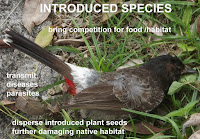SETTLEMENT IMPACTS ON BIRDS OF HAWAII
IMPACTS OF SETTLEMENT BY HUMANS ON THE BIRDS OF HAWAII
The settlement of the Hawaiian Islands by humans started some 1,800 years ago, and continued with the arrival of the Europeans in the late 1700s. These humans brought with them domestic and other animals and plants. Some of those animals turned into bird predators, such as rats, mongoose and cats. The Javan Mongoose and the Red-vented Bulbul (see photos below) are currently listed as ‘Injurious Wildlife’ by the Hawaii Invasive Species Council. Other introduced mammals such as grazing goats and pigs destroyed native bird habitat.
Bird habitat encroachment due to development for agriculture and infrastructure for cities was – and is – another issue. Still another factor is invasion of endemic bird territory by introduced bird species. Some introduced birds have inter-bred with native species, for example the Mallard with the Hawaiian Duck (see photo below).
Finally, avian diseases brought by introduced species severely impacted endemic species, because they had no immunity against them. As a result of all these impacts many endemic species went extinct and others are critically endangered. Here’s a list of the endemic birds of Hawaii with their status.
 |
| Predators introduced on Hawaii On photo: Javan Mongoose |

